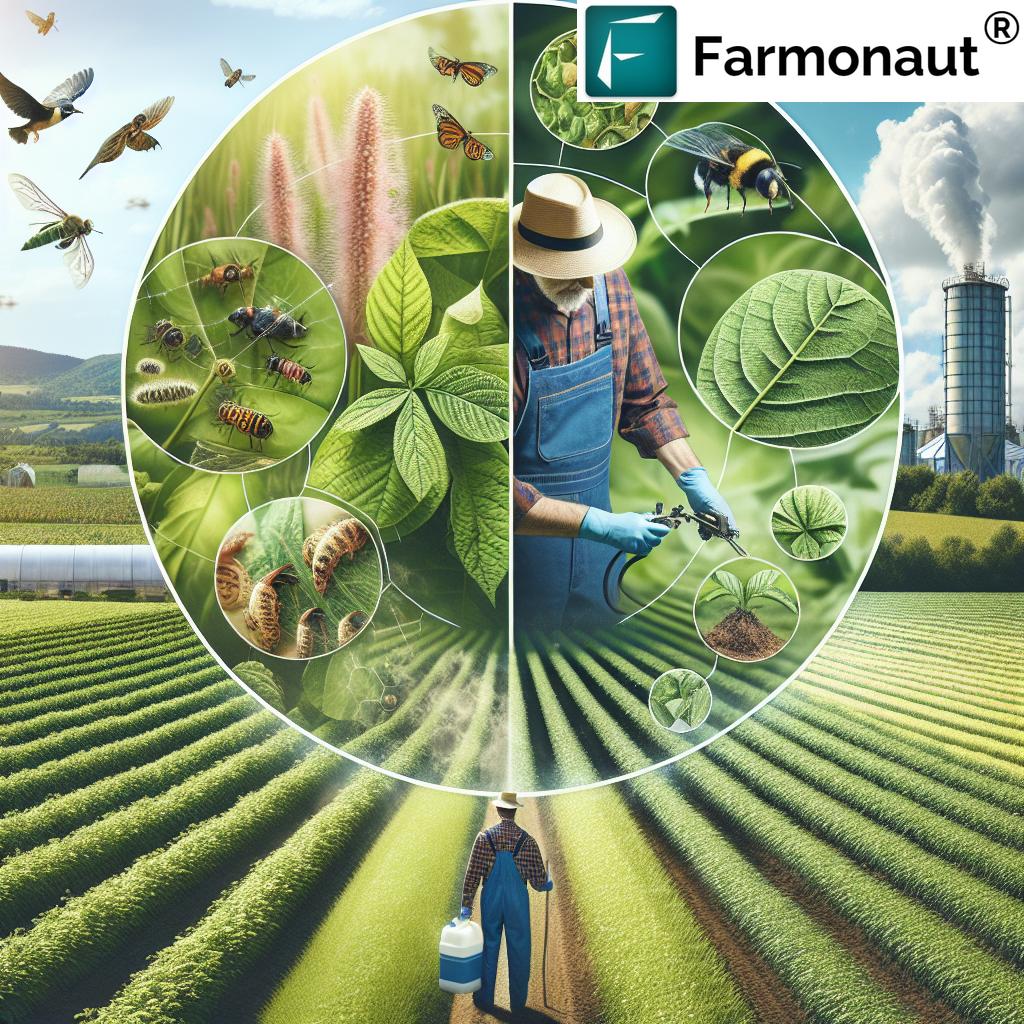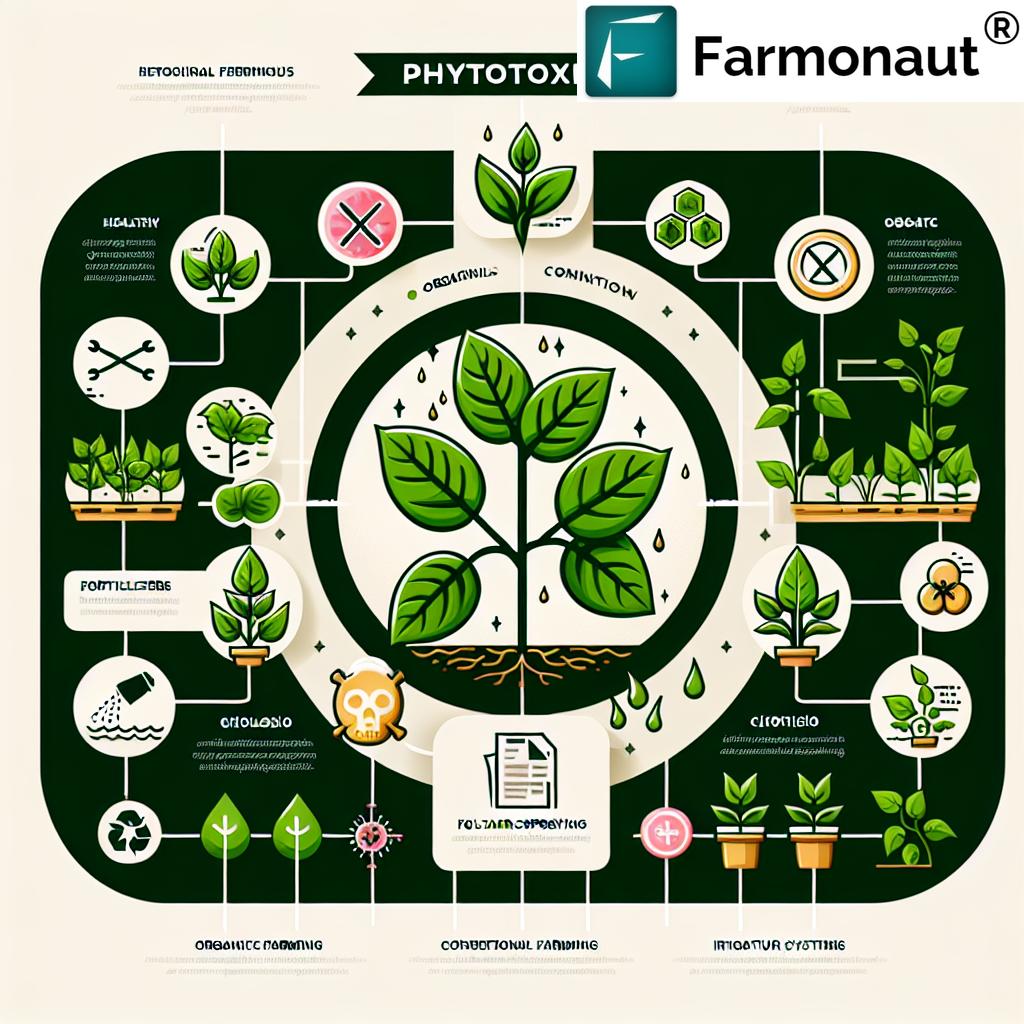Organic vs. Conventional: Understanding Phytotoxicity in Crop Protection and Pest Control

In the ever-evolving world of agriculture, we at Farmonaut are committed to providing farmers with cutting-edge solutions to maximize crop yields while maintaining sustainable practices. One of the critical challenges faced by both organic and conventional farmers is phytotoxicity – a phenomenon that can significantly impact crop health and productivity. In this comprehensive guide, we’ll delve deep into the world of phytotoxicity, exploring its causes, symptoms, and management strategies in both organic and conventional farming systems.
What is Phytotoxicity?
Phytotoxicity refers to the toxic effect of a compound on plant growth or function. In agriculture, it often occurs when crops are exposed to substances that can harm them, whether these are natural or synthetic chemicals used for pest control or plant protection.
Causes of Phytotoxicity in Agriculture
Phytotoxicity can arise from various sources in both organic and conventional farming systems:
- Overuse or misapplication of pesticides or herbicides
- Inappropriate timing of chemical applications
- Environmental factors such as extreme temperatures or humidity
- Interaction between different chemical compounds
- Residual chemicals in the soil from previous applications
Recognizing Phytotoxicity Symptoms
Identifying phytotoxicity early is crucial for minimizing crop damage. Common symptoms include:
- Leaf discoloration (yellowing, browning, or bronzing)
- Stunted growth or plant deformities
- Leaf burn or scorching
- Wilting or drooping of leaves
- Reduced yield or fruit quality

Phytotoxicity in Organic Farming
While organic farming eschews synthetic chemicals, it’s not immune to phytotoxicity issues. Organic farmers must be vigilant when using natural substances for pest control and plant protection.
Common Causes of Phytotoxicity in Organic Systems:
- Overuse of copper-based fungicides
- Misapplication of neem oil or other botanical pesticides
- Improper use of sulfur-based products
- Accumulation of allelopathic compounds from cover crops
Managing Phytotoxicity in Organic Farming:
- Proper Application Techniques: Ensure correct dilution and application methods for organic pesticides and fungicides.
- Timing: Apply treatments during cooler parts of the day to reduce the risk of leaf burn.
- Crop Rotation: Implement diverse crop rotations to prevent the buildup of allelopathic compounds.
- Regular Monitoring: Use Farmonaut’s satellite-based crop health monitoring to detect early signs of stress or phytotoxicity.
Phytotoxicity in Conventional Farming
Conventional farming systems often rely on synthetic chemicals for pest control and crop management, which can increase the risk of phytotoxicity if not used correctly.
Common Causes of Phytotoxicity in Conventional Systems:
- Overdosing of herbicides or pesticides
- Tank mix incompatibilities
- Drift from nearby chemical applications
- Residual herbicide carryover in the soil
Managing Phytotoxicity in Conventional Farming:
- Precision Application: Utilize precision agriculture techniques, such as Farmonaut’s satellite-guided spraying systems, to ensure accurate chemical placement.
- Weather Monitoring: Consider environmental conditions before applying chemicals to reduce drift and volatilization risks.
- Integrated Pest Management (IPM): Implement IPM strategies to reduce reliance on chemical interventions.
- Regular Soil Testing: Monitor soil health to prevent accumulation of toxic residues.
The Role of Application Methods in Phytotoxicity
The method of applying crop protection products can significantly influence the risk of phytotoxicity. Let’s explore some common application techniques and their potential impact:
Foliar Spraying
Foliar spraying is a widely used method for applying pesticides, fungicides, and nutrients directly to plant leaves. While effective, it carries a higher risk of phytotoxicity if not done correctly.
- Pros: Rapid uptake of nutrients and pesticides, targeted application
- Cons: Increased risk of leaf burn, potential for drift
Best Practices for Foliar Spraying:
- Use appropriate nozzles and pressure settings to ensure even coverage
- Apply during cooler parts of the day to reduce evaporation and leaf burn
- Avoid spraying during windy conditions to minimize drift
Soil Applications
Applying products directly to the soil can be an effective way to deliver nutrients and pesticides while minimizing foliar phytotoxicity risks.
- Pros: Reduced risk of foliar phytotoxicity, slower release of nutrients
- Cons: Potential for soil accumulation, slower uptake by plants
Best Practices for Soil Applications:
- Incorporate products into the soil to prevent surface runoff
- Consider soil pH and organic matter content when determining application rates
- Use precision application techniques to target specific areas
Irrigation Systems
Integrating crop protection products into irrigation systems (chemigation) can provide efficient and uniform distribution.
- Pros: Uniform application, reduced labor costs
- Cons: Potential for system clogging, risk of groundwater contamination
Best Practices for Irrigation System Applications:
- Ensure proper system maintenance and calibration
- Use products specifically formulated for chemigation
- Monitor water quality and pH to prevent interactions
The Impact of Environmental Factors on Phytotoxicity
Environmental conditions play a crucial role in determining the likelihood and severity of phytotoxicity. Understanding these factors can help farmers mitigate risks:
Temperature
High temperatures can increase the risk of phytotoxicity by enhancing the uptake and translocation of chemicals within plants.
- Avoid applying chemicals during the hottest parts of the day
- Be cautious when using oil-based products in hot weather
Humidity
High humidity can prolong the drying time of foliar sprays, increasing the risk of phytotoxicity.
- Consider using adjuvants to improve spray retention and penetration
- Adjust application timing to periods of lower humidity when possible
Rainfall
Rain soon after application can wash off foliar sprays, reducing efficacy and potentially causing runoff issues.
- Check weather forecasts before applying chemicals
- Use stickers or spreaders to improve rainfastness
Wind
Windy conditions can cause spray drift, leading to uneven application and potential damage to non-target plants.
- Use drift-reduction nozzles and lower spray pressures in windy conditions
- Consider using buffer zones near sensitive areas
Innovative Technologies for Mitigating Phytotoxicity Risks
At Farmonaut, we’re at the forefront of developing cutting-edge technologies to help farmers manage phytotoxicity risks more effectively. Here are some innovative solutions we offer:
Satellite-Based Crop Health Monitoring
Our advanced satellite imagery technology allows farmers to detect early signs of crop stress and potential phytotoxicity across large areas quickly and efficiently.
- Real-time vegetation health indices (NDVI)
- Early detection of stress patterns
- Historical data comparison for trend analysis
Learn more about our satellite-based monitoring system: Farmonaut App
AI-Powered Advisory System
Our Jeevn AI system provides personalized recommendations to help farmers make informed decisions about chemical applications and pest management strategies.
- Customized application timing recommendations
- Product compatibility checks
- Weather-based application alerts
Precision Application Technologies
We offer integration with precision spraying equipment to ensure accurate and uniform chemical applications, reducing the risk of over-application and phytotoxicity.
- Variable rate application maps
- GPS-guided spraying systems
- Automated nozzle control
Comparing Phytotoxicity Detection Methods
| Detection Method | Speed | Accuracy | Cost-Effectiveness |
|---|---|---|---|
| Visual Inspection | Slow | Moderate | Low |
| Leaf Tissue Analysis | Slow | High | Moderate |
| Drone Imaging | Moderate | High | Moderate |
| Farmonaut Satellite System | Fast | High | High |
As shown in the table, Farmonaut’s satellite-based system offers a unique combination of speed, accuracy, and cost-effectiveness in detecting phytotoxicity symptoms across large areas. This enables timely intervention and reduces crop damage in both organic and conventional farming systems.
Case Studies: Successful Phytotoxicity Management
Organic Apple Orchard
An organic apple farmer in Washington state was struggling with recurring fungal infections. Using copper-based fungicides led to leaf burn and reduced yields. By implementing Farmonaut’s satellite monitoring system, the farmer was able to:
- Detect early signs of fungal stress before visible symptoms appeared
- Optimize the timing and concentration of organic fungicide applications
- Reduce overall fungicide use by 30% while improving fruit quality
Conventional Soybean Farm
A large-scale soybean operation in the Midwest was experiencing unexplained yield reductions. Using our AI-powered advisory system and precision application technology, the farm management team:
- Identified areas of herbicide over-application causing crop stress
- Implemented variable-rate spraying to optimize herbicide use
- Increased overall yield by 15% while reducing herbicide costs
The Future of Phytotoxicity Management
As we look to the future, several emerging technologies and approaches show promise in further reducing phytotoxicity risks:
Nanotechnology
Nanoformulations of pesticides and fertilizers could allow for more precise delivery and reduced phytotoxicity risks.
Gene Editing
CRISPR and other gene-editing technologies may help develop crops with increased tolerance to certain chemicals or environmental stressors.
Biostimulants
Natural compounds that enhance plant stress tolerance could help mitigate the effects of mild phytotoxicity.
Artificial Intelligence and Machine Learning
Advanced AI algorithms could provide even more accurate predictions of phytotoxicity risks based on complex environmental and agronomic data.
Conclusion
Phytotoxicity remains a significant challenge in both organic and conventional farming systems. However, with a deep understanding of its causes, symptoms, and management strategies, farmers can minimize risks and optimize crop protection practices. By leveraging innovative technologies like Farmonaut’s satellite-based monitoring and AI-powered advisory systems, farmers can stay ahead of potential phytotoxicity issues and ensure healthy, productive crops.
Remember, successful phytotoxicity management requires a holistic approach that considers all aspects of crop production, from soil health to application techniques. By staying informed and adopting best practices, we can work together to create more resilient and sustainable agricultural systems.
FAQs
Q: What is the difference between phytotoxicity and nutrient deficiency?
A: While both can cause plant stress, phytotoxicity is caused by exposure to toxic substances, whereas nutrient deficiency results from a lack of essential nutrients. Symptoms can sometimes be similar, making accurate diagnosis crucial.
Q: Can organic pesticides cause phytotoxicity?
A: Yes, even natural or organic pesticides can cause phytotoxicity if used improperly. It’s essential to follow application guidelines carefully, regardless of whether the product is organic or synthetic.
Q: How long does it take for phytotoxicity symptoms to appear?
A: Symptoms can appear within hours or days of exposure, depending on the substance, concentration, and environmental conditions. Some effects may not be visible for weeks, especially in the case of soil-applied chemicals.
Q: Can plants recover from phytotoxicity?
A: In many cases, plants can recover from mild phytotoxicity if the exposure is limited and proper care is provided. However, severe cases may lead to permanent damage or plant death.
Q: How can I prevent phytotoxicity when mixing different chemicals?
A: Always check product labels for compatibility information. Perform a jar test before mixing large quantities, and use Farmonaut’s AI advisory system for personalized recommendations on chemical interactions.
Q: Are there any crops that are particularly susceptible to phytotoxicity?
A: Some crops, such as grapes, tomatoes, and certain ornamental plants, are known to be more sensitive to chemical damage. However, susceptibility can vary based on growth stage, environmental conditions, and specific chemical formulations.
Q: How can satellite imagery help in managing phytotoxicity?
A: Satellite imagery, like that provided by Farmonaut, can detect early signs of plant stress across large areas. This allows farmers to identify potential phytotoxicity issues before they become visible to the naked eye, enabling prompt intervention.
Q: What role does soil pH play in phytotoxicity?
A: Soil pH can significantly influence the availability and uptake of chemicals by plants. Some substances become more phytotoxic in acidic or alkaline soils, making pH management an important factor in preventing chemical damage.
Q: Can adjuvants help reduce phytotoxicity risks?
A: Yes, certain adjuvants can help reduce phytotoxicity by improving spray coverage, reducing drift, or altering the pH of the spray solution. However, it’s important to choose adjuvants carefully, as some combinations may increase phytotoxicity risks.
Q: How often should I monitor my crops for signs of phytotoxicity?
A: Regular monitoring is crucial, especially after applying any crop protection products. With Farmonaut’s satellite monitoring system, you can receive daily updates on crop health, allowing for continuous vigilance against potential phytotoxicity issues.

